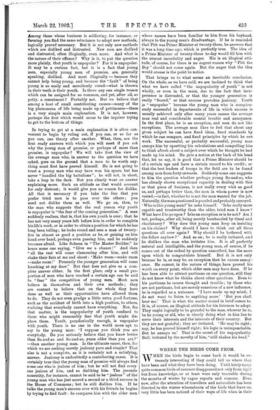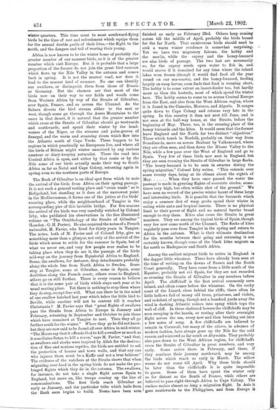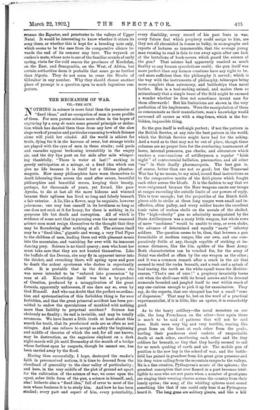WHERE THE BIRDS COME FROM.
WHEN the birds begin to come back it would be ex- tremely interesting if they could tell us where they have been and what they have been doing. Until lately many quite common birds of summer disappeared not only from sight but from knowledge, or at least were only traceable during the months of winter by vague reports and rumour. Even now, after the attention of travellers and naturalists has been directed to the winter whereabouts of the birds that leave us, very little has been noticed of their ways of life when in their
winter quarters. This time must to most southward-flying birds be the time of rest and refreshment which equips them for the annual double perils of their lives,—the flight to the north, and the dangers and toil of rearing their young.
Africa is now known to be the winter home of probably the greater number of our summer birds, as it is of the greater number which visit Europe. But it is probable that a large proportion of the former do not join the great bird caravan which flows up the Nile Valley in the autumn and cornea back in spring. It is not the nearest road, nor does it lead to the nearest land of summer. No one can identify our swallows, or distinguish them from those of Russia or Germany. But the chances are that most of the birds now on their way to our fields and woods come from Western Africa by way of the Straits of Gibraltar, over Spain, France, and so across the Channel. As the Sahara diverts the bird stream either to the east or west, though some go through the Aures Mountains to the oases in that desert, it is natural that the greater number which cross at the Straits of Gibraltar should go westwards and southwards, and spend their winter by the head- waters of the Niger, or the streams and palm-groves of Senegal, and the warm and steaming rivers which flow into the Atlantic south of Cape Verde. These happen to be regions in which practically no Europeans live, and where all the birds of Britain might winter unnoticed by any curious amateur or diary-keeping naturalist. There the road into Central Africa is open, and either by that route or by the Nile some of our birds actually make their way to South Africa as far as Natal and Cape Colony, returning again in spring even to the northern parts of Europe.
The Rock of Gibraltar is an ideal spot from which to note the arrival of the birds from Africa on their spring passage. It is not such a general resting place and " cross roads " as is Heligoland, but standing as it does at the narrowest point in the Mediterranean, it forms one of the jetties at the birds' crossing place, while the neighbourhood of Tangier is the corresponding pier of this invisible bridge. For five seasons the arrival of the birds was very carefully watched by Colonel Irby, who published his observations in the fine illustrated volume on " The Ornithology of the Straits of Gibraltar " (London : G. H. Porter). He also acquired the notes of a French naturalist, M. Favier, who lived for thirty years in Tangier. The notes, both of M. Favier and of Colonel Irby, give us something more than a glimpse, not only of the arrival of the birds which mean to settle for the summer in Spain, but of what we never see, and very few people ever realise to be taking place when they do see it, the passage of the birds mid-way on the journey from Equatorial Africa to England. Some, the swallows, for instance, drop detachments probably along the whole line from North Africa to Sweden. Some stop at Tangier, some at Gibraltar, some in Spain, some doubtless along the French coast; others come to England, others go on still further. There is every reason to believe that it is the same pair of birds which stays each year at its usual nesting place. Yet there is nothing to stop them where they do stop, except free will. What can there be in the mind of one swallow hatched last year which takes the little bird to Seville, while another will not be content till it reaches Christiania ? M. Favier says that " great flights of swallows pass the Straits from Africa to Europe in January and February, returning in September and October to join those which have remained at Tangier to nest. Then they all go further south for the winter." Where they go he did not know, but they are now said to be found all over Africa in mid-winter. "The Moors say that it offends God to kill a swallow as much as it conciliates Satan to kill a raven," says M. Favier, " and that, as swallows and storks were inspired by Allah for the destruc- tion of flies and noxious reptiles, the birds are entitled to ask the protection of houses and town walls, and that any one who injures them must be a Kaffir and not a true believer." The evidence of the watchers at the Straits shows that when migrating over land in the spring birds do not make the pro- longed flights which they do in the autumn. The swallows, for instance, do not take a single flight across Spain to England, but move on, like troops coming up the line of communications. The first birds reach Gibraltar as early as January, and the particular tribe which hails from the Rock soon begins to build. Nentaa have been seen
finished as early as February 23rd. Others keep coming across till the middle of April, probably the birds bound for the far North. That carnivorous birds should need to seek a warm winter residence is somewhat surprising. Yet we have two migratory falcons, the hobby and the merlin, while the osprey and the honey-buzzard are also birds of passage. The two last are necessarily so, for the osprey needs open water to fish in, and would starve if it remained for any time where the inland lakes were frozen (though it would find food all the year round on our sea-coasts), and the honey-buzzard, feeding
largely on wasp larvae, soon finds that food is running short. The hobby is to some extent an insect-feeder too, but hardly more so than the kestrels, most of which spend the winter here. The hobby seems to come to us across Central Europe from the East, and also from the West African region, where it is found in the Canaries, Morocco, and Algeria. It ranges quite down to Cape Colony and returns very late in the spring. In this country it does not nest till June, and is not seen at the half-way house, at the Straits, before the beginning of May. There, too,' is the crossing place of the honey-buzzards and the kites. It would seem that the former leave England and the North for two distinct "objectives." Those which touch in Norfolk, probably on their way from Scandinavia, move on across Brabant by Valkensvard, where they are often seen, and then down the Rhone Valley to the Nile, while a few pass over the West of England and go to Spain. Very few of these birds now nest in England, but they are seen crossing the Straits of Gibraltar in large flocks. "The honey-buzzard is to be seen in swarms during the spring migration," Colonel Irby writes. "This extends over some twenty days, being at its climax about the eighth of May When they have once passed the water the passage is made in gyrating flights of eccentric circles, some- times very high, but often within shot of the ground." We have seen no record of the precise winter haunt of these large and interesting birds. It is possible that the buzzards which enjoy a summer diet of wasp grubs spend their winter in eating white ants and tropical insects. There is no physical limit to their power of flight and no natural barrier broad enough to stop them. Kites also cross the Straits in great numbers. They are among the typical birds of Spain, though very few now come north of the Channel. The flocks of kites regularly pass over from Tangier in the spring and return to Africa in the autumn. What is their ultimate destination for the months between their going and returning is not certainly known, though some of the black kites migrate as far south as Madagascar and South Africa.
Among the earliest migrant birds to arrive in England is the dapper little wheatear. These have already been seen at the time of writing on the downs of Sussex and the South Coast generally. They have come from a little south of the Equator, probably not via Spain, for they are not recorded as crossing the Straits of Gibraltar in any numbers before April. The chiffchaff is the first arrival commonly seen inland, and often comes before the wheatear. On the rocky coast of the Lizard, close behind the cliffs, there often lie little hollows full of mossy old trees, primroses, and violets, and redolent of spring, though not a hundred yards away the wind is dashing Atlantic rollers into spray which tops the wall of cliff. In these sheltered bowers the chiffchaffs may be seen creeping in the hazels, or resting after their overnight flight across the sea, every now and then breaking out into a few notes of song. A few chiffchaffs are believed to remain in Cornwall, but many of the others, in advance of modern fashion, have always gone up the Nile for the cold season, and wintered as far south as Abyssinia. They probably also pass down to the West African region, for chiffchaffs cross the Straits of Gibraltar in great numbers, and very early. Some arrive there in February, and these, if they continue their journey northward, may be among the birds which reach us early in March. The willow wrens do not come till April. Why these birds should be later than the chiffchaffs it is quite impossible to guess. Some of them have spent the winter only as far distant as the South of France, while others are believed to pass right through Africa to Cape Colony. The cuckoo makes almost as long a migration flight. In ,Asia it goes southwards to the Philippines, and from .Europe it eroeses • the Equator, and penetrates to the valleys of Upper Natal. It would be interesting to know whether it utters its song there, or whether this is kept for a breeding note only, which seems to be the case from its comparative silence to- wards the end of its summer stay here. The wryneck or cuckoo's mate, whose note is one of the familiar sounds of early spring, visits for the cold season the provinces of Kordofan, on the East, and Senegambia, on the West, of Africa, but certain authorities deem it probable that some go no further than Algeria. They do not seem to cross the Straits of Gibraltar in any number. Why they should choose another place of passage is a question open to much ingenious con- jecture.-












































 Previous page
Previous page